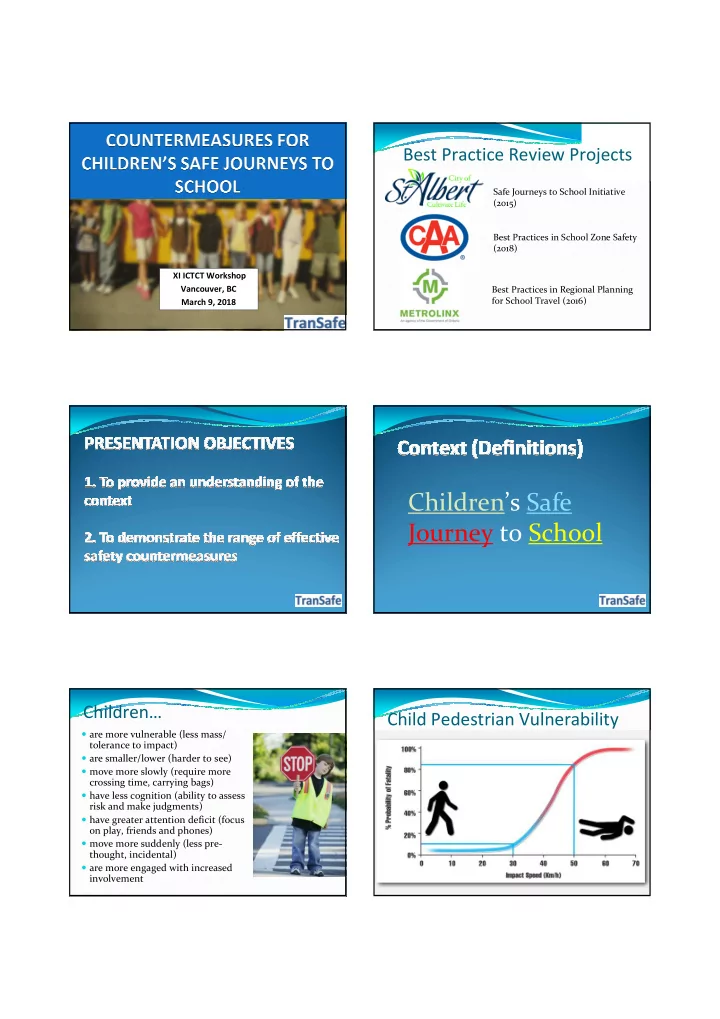

34543 Best Practice Review Projects 53 4 Safe Journeys to School Initiative (2015) Best Practices in School Zone Safety (2018) XI ICTCT Workshop Vancouver, BC Best Practices in Regional Planning for School Travel (2016) March 9, 2018 Children’s Safe Journey to School Children… Child Pedestrian Vulnerability � are more vulnerable (less mass/ tolerance to impact) � are smaller/lower (harder to see) � move more slowly (require more crossing time, carrying bags) � have less cognition (ability to assess risk and make judgments) � have greater attention deficit (focus on play, friends and phones) � move more suddenly (less pre- thought, incidental) � are more engaged with increased involvement
“Journey” Considerations Factors Impacting Child Perception of What is “Safe” � Departure / reversing � Comfort / Easy / Direct � Parent drop-off / � Road type/noise pick-up choices � Crossing distance � Sidewalks � Level of crossing protection � Bicycle facilities � Level of communication � Crossing locations � Weather (risk of freezing, slipping/falling) � Interfaces � Security � Arrival (school � Emotional (esp. with parents) property) Journey Distance Journey Distance Mode Choice (St. Albert, Alberta) 47% Mode Split (spring/fall): Mode Split (winter): � 46% bus � 47% bus � 28% car � 37% car � 18% walk � 13% walk � 6% bike � 0% bike “School” Definition � School Zone / Area � School frontage � School property and entrances Layouts and access points are highly variable…each school is different!
Safe Journey Countermeasures Engagement Methodology Based on balanced evidence from several sources: � Collisions � Infrastructure Observations � Behavioural Observations (incl. traffic conflicts) � Best Practice Research � Engagement Activities Principle #1: Promotion of Active Travel Modes SUPPORTING STRATEGIES: � “Walking/Cycling School Buses” � Theme days and contests � Discuss weather barriers � Do walkabouts/bikeabouts � Develop safe routes to school maps � Work with cycling groups � Pilot bike lanes / road diets � Rear pathways / alternate entrances � Keep facilities free of snow Walking School Bus Principle #2: Shift to School Bus Transportation SUPPORTING STRATEGIES: � Driver training programs � More flexible cost structure � On-board storage � On-board surveillance � Address issues at bus stops � Optimize routes to avoid congestion � Proximity to school entrances � Collision avoidance technology � Winterization of school buses/tires � Spacious passenger waiting areas
Principle #3: Speed Management Passenger Waiting Area SUPPORTING STRATEGIES: � Gateway treatments � Real-time flashers � Speed zone reminders � Speed reader-boards and follow-up enforcement � Rewards for compliance � Raised crosswalks/curb extensions � Targeted speed enforcement � Automated speed enforcement Raised Crosswalk Gateway Treatment Principle #5: Enhanced Crossing Facilities Principle #4: Management of Winter Conditions SUPPORING STRATEGIES: SUPPORTING STRATEGIES: � Revised hierarchy of controls � Discuss concerns with students � No Stopping within 10-15 metres of crosswalks � Reflective/climate-appropriate � Curb extensions/Raised crosswalks/In-street signs clothing � Use of zebra/ladder markings at school crossings � Snow blading policy � Higher visibility markings � Sidewalk clearing policy � Enhanced student patrols, Adult guards for unique cases � Windrow clearance policy � Temporary measures (e.g. cones) � “Winter app” to report � Illumination of pathways/crosswalks windrows � Advance warning measures � Enhanced signage and warning � Maintenance of shrubs � Enhanced crosswalks � Automated pedestrian detection
High-Visibility Crosswalk Principle #6: Well-sited and planned school sites SUPPORTING STRATEGIES: � Multiple frontage / corner � Separates access points for buses and vehicles/staff � Reverse-in staff parking in central part of lot � Location of school entrances � Low fences/shrubs to prevent jaywalking � Stacking at the downstream end � One-way on-site circulation � Sidewalks outside of driveways � Consistent on-site signage � Staggered hours for nearby schools Principle #7: Optimize Use of PU/DO Areas SUPPORTING STRATGIES: � Separation of buses and vehicles � Institute “No unattended vehicles” � Shorter times for pick-up/drop-off � Restrict stopping across the street � Possibility of shared zones outside of peaks � Use of positive/symbolic signing � Busing / parking patrols � Approach from/park on same side � Use of City parking lots where Direct connection from sidewalks and bus available zone to school entrance Cultural Transformation Principle #8: Traffic Safety Governance SUPPORTING STRATEGIES: � Public traffic safety committee � School-based traffic safety committees � Dedicated funding for traffic safety � Continued, expanded collaboration between all partners � Standardized student newsletter content � Traffic fines that better reflect risk � RCMP members dedicated to school safety � Maintain Safe Journeys website � Implement/enhance curriculum � Review locations/corridors raised as concerns � Traffic Conflict monitoring program
City of St. Albert Safe Journeys Website: http://stalbert.ca/living-here/community- directory/schools/safe-journeys/ Raheem Dilgir, P.Eng., PTOE, MBA (604)563-9988 | raheem@transafe.ca
Recommend
More recommend